|
Stirring Up the Witch's
Brew
by Bob Brooke
 For
many people, Fall is their favorite time of year because it brings with
it Halloween. And for many their favorite Halloween motif is the
witch—riding her broom through the crisp night sky. For
many people, Fall is their favorite time of year because it brings with
it Halloween. And for many their favorite Halloween motif is the
witch—riding her broom through the crisp night sky.
Witch, or "Wica" came from the Wiccas who performed rituals among the
Celts in ancient times. Often portrayed on a broom or standing over a
cauldron, these images derive from the wica rituals of potion making and
divination. Superstitions abound, and black cats were often said to be a
witch in disguise.
In the 17th century, Salem, Massachusetts, was the site of the infamous
Salem witch trials. Today, it’s brimming with all sorts of Salem witch
souvenirs.
Witches haven’t always been a popular fun motif. For centuries, being
accused of being a witch often meant death by some horrible means—often
being burned at the stake. Superstition ran rampant in past times when
science was in its early stages and religion and mysticism ruled.
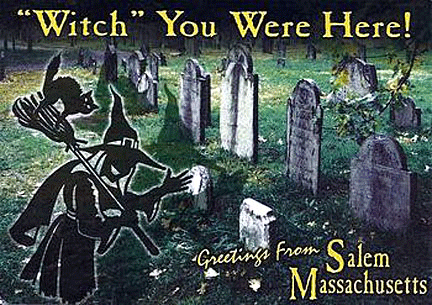
Though hunting down witches had been going on for centuries, it really
got a kick start in 11th-century Europe when accusations of witchcraft
fell upon anyone who did any sort of perceived evil deed. This was
especially true of persons, usually women, who made herbal medicines and
recipes for spells to cure the sick.
The Puritans came to the New World to escape persecution and ended up
being more intolerant than anyone. They brought with them all the
superstitions they had lived with in their home countries. And that
included their belief in witchcraft.
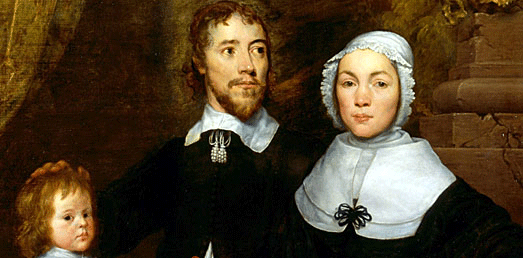
Salem was a depressing place in 1692. Neighbors bickered continuously
over boundary lines and politics. The strict demands of Calvinism
allowed no frivolity and little joy. Work lasted six days a week and on
the seventh, people spent their day listening to dire warnings of
Satan's nearness by harsh, punitive ministers. One of the most evil of
temptations was sexuality. Fear and repression filled the Puritans daily
lives. The settlers feared attacks by Indians and had only recently
recovering from a smallpox epidemic. Any activities that stimulated
mental or physical excitement were deemed sinful. So it’s easy to see
how a group of teenage girls with an excess of energy and pent up
emotion, coming in direct conflict with severe repression, could become
obsessed with their own wild imaginings and sexual fantasies.
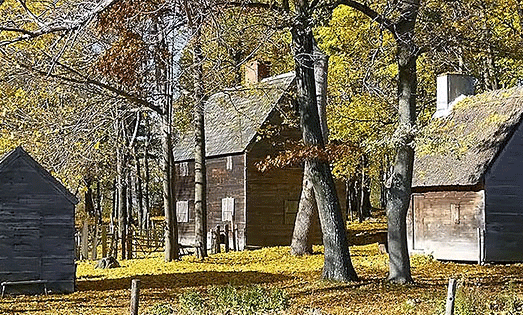
 But
scientists and historians now believe that the hysterical girls were
victims of either a poisonous fungus found in the bread made and eaten
in the settlement or from hallucinations they suffered from the hemp
they chewed to make it pliable for making rope. But the stage had long
ago been set for the tragedy that was to befall those girls. Historians
believe that over 9 million people, nearly all of them women, were the
victims of witch hunts and burnings for five previous centuries. But
scientists and historians now believe that the hysterical girls were
victims of either a poisonous fungus found in the bread made and eaten
in the settlement or from hallucinations they suffered from the hemp
they chewed to make it pliable for making rope. But the stage had long
ago been set for the tragedy that was to befall those girls. Historians
believe that over 9 million people, nearly all of them women, were the
victims of witch hunts and burnings for five previous centuries.
In Europe, witch hunting was a profitable business. Local nobles,
bishops. judges, magistrates and others all received a share of the
wealth created from the picked pockets and stolen property of arrested
citizens. Local government officials charged victims for the ropes that
bound them and the wood that burned them. It wasn’t much different in
Salem. Those who were jailed had to pay the jailer for food and the
chains that held therm. Officials confiscated personal property to pay
increasing debts. Some people who were later released fought for years
to reclaim their stolen property.
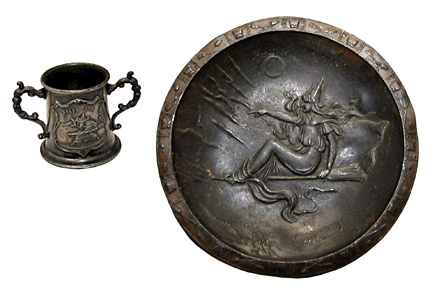 Though
original artifacts from this time period are rare, memorabilia such as
Jonathan Corwin's trunk, accused Mary Hollingsworth English's sampler,
Philip English's chair, cane and bottle and John Proctor's brass sundial
do exist. There are also 552 documents related to the trials, known
collectively as "The Salem Witchcraft Papers," including arrest
warrants, examinations and death warrants. Also in this collection are
the witch pins, claimed by the accusers to have been used by the
"witches" to torment their victims. Though
original artifacts from this time period are rare, memorabilia such as
Jonathan Corwin's trunk, accused Mary Hollingsworth English's sampler,
Philip English's chair, cane and bottle and John Proctor's brass sundial
do exist. There are also 552 documents related to the trials, known
collectively as "The Salem Witchcraft Papers," including arrest
warrants, examinations and death warrants. Also in this collection are
the witch pins, claimed by the accusers to have been used by the
"witches" to torment their victims.
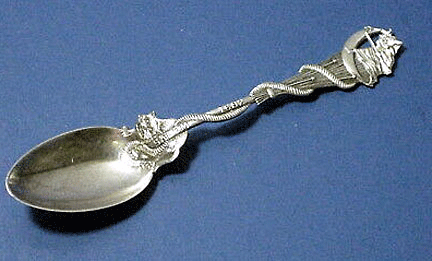 Victorians
of the latter part of the 19th century loved to travel. And visitors
wanted to take home souvenirs of their journeys, either natural or
manmade. Daniel Low, the owner of a gift and silver shop in Salem,
decided that the town could benefit from the types of souvenir pieces he
had seen during trips to Europe. He first created a silver spoon with a
witch design, complete with a broom and the word “Salem.” Low marked it
"D Low Sterling" and a circle D for Durgin Silversmiths on the reverse
side. Its popularity soon encouraged him to create another. As his
spoons began selling wildly, the witch image quickly became Salem's
symbol. Low was the first to make souvenirs for tourists in the U.S. Victorians
of the latter part of the 19th century loved to travel. And visitors
wanted to take home souvenirs of their journeys, either natural or
manmade. Daniel Low, the owner of a gift and silver shop in Salem,
decided that the town could benefit from the types of souvenir pieces he
had seen during trips to Europe. He first created a silver spoon with a
witch design, complete with a broom and the word “Salem.” Low marked it
"D Low Sterling" and a circle D for Durgin Silversmiths on the reverse
side. Its popularity soon encouraged him to create another. As his
spoons began selling wildly, the witch image quickly became Salem's
symbol. Low was the first to make souvenirs for tourists in the U.S.
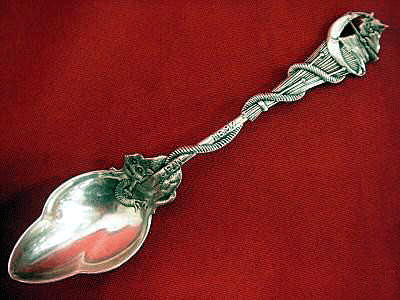
 Low
patented his witch design on Jan. 13, 1891. The second spoon pattern,
introduced in 1893, was much more ornate, having in its design a witch
on a crescent moon, a cat, the three pins, the date of 1692, a hemp rope
and a handle of a witch's broom. The design twines around the back of
the spoon and shows the frayed end of the rope. Low
patented his witch design on Jan. 13, 1891. The second spoon pattern,
introduced in 1893, was much more ornate, having in its design a witch
on a crescent moon, a cat, the three pins, the date of 1692, a hemp rope
and a handle of a witch's broom. The design twines around the back of
the spoon and shows the frayed end of the rope.
The success of these spoons was so enormous they began a souvenir craze
across the country. Low then began a line of items for the Witch City
trade that would he imitated by towns and cities across the United
States, Canada, and Europe. He offered quality sterling silver souvenir
items that included tea strainers, bookmarks, perfume bottles,
matchsafes and dishes. Soon tourists insisted on more items at a
moderate price.
Other companies jumped an the souvenir bandwagon, creating items of
china, glass, pottery and celluloid. Souvenir manufacturers presented
dishes, sewing equipment, household implements, dresser items, and
jewelry, for sale to eager tourists.
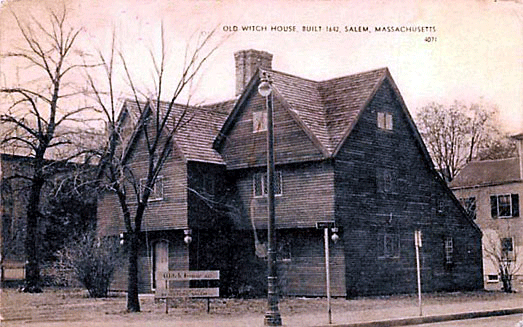
 Photography
had come into its own by the last decades of the 19th century and
postcards became a popular souvenir item. Tourists snapped them up. In
fact, Jonathan Corwin's home where the trials took place, called the
Witch House, has been pictured on postcards so often over the years,
that postcards eventually documented changes in the site. So many
publishers and printers have produced cards of this structure that
prices are low because they are so common. They usually range between $1
and $6. Photography
had come into its own by the last decades of the 19th century and
postcards became a popular souvenir item. Tourists snapped them up. In
fact, Jonathan Corwin's home where the trials took place, called the
Witch House, has been pictured on postcards so often over the years,
that postcards eventually documented changes in the site. So many
publishers and printers have produced cards of this structure that
prices are low because they are so common. They usually range between $1
and $6.
A variety of Salem witch souvenirs, including pins, spoons, plates,
sheet music, and postcards sell for $40 or so at auctions. Spoons can
sell for $150 or more, depending on their condition.
While most people are familiar with the Salem witch trials, few know
that the Salem witch memorabilia associated with the trials helped to
launch the American souvenir industry.
<
More Special Features
Next Article >
|
